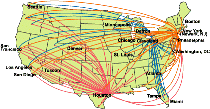United States Department of Transportation

United States Department of Transportation: Publications
Date of this Version
2003
Abstract
OPS distributes its R&D budget among four main areas. For example, in fiscal year 2003, the office plans to allocate its $8.7 million budget as follows:
• 46 percent ($4.0 million) to developing new technologies to prevent damage to pipelines and prevent leaks;
• 21 percent ($1.9 million) to improving technologies for operating, controlling, and monitoring the condition of pipelines;
• 19 percent ($1.7 million) to improved pipeline materials, such as materials that are resistant to damage and defects; and
• 14 percent ($1.2 million) to efforts to improve data on the location and safety performance of pipelines.
On the basis of our work, we believe that OPS’s R&D funding is generally aligned with its mission and pipeline safety goals. OPS has taken a number of steps to ensure this alignment. For example, it obtained the views of a variety of experts and stakeholders in deciding on its R&D priorities and has described in various plans how its R&D efforts can lead to new and improved technologies that can help achieve its safety performance goals, such as reducing the impacts of pipeline accidents.
The pipeline safety R&D priorities of the experts we surveyed are generally consistent with OPS’s R&D priorities. For example, most assigned a high priority to the two areas of R&D that receive the highest amount of funding from OPS.
OPS’s efforts to evaluate the outcomes of its R&D have been limited. The agency has taken some preliminary steps toward developing an evaluation process for its R&D program, such as identifying possible measures of program results. Leading research organizations, the Office of Management and Budget, and GAO have identified a number of best practices for systematically evaluating the outcomes of federal R&D programs, such as setting clear R&D goals, measuring progress toward goals, and reporting periodically on evaluation results. These best practices can help OPS to determine the effectiveness of its R&D program in achieving desired outcomes, such as the development and use of new and improved technologies that can enhance pipeline safety.


Comments
Published in GAO-03-746 (2003) 48 p.